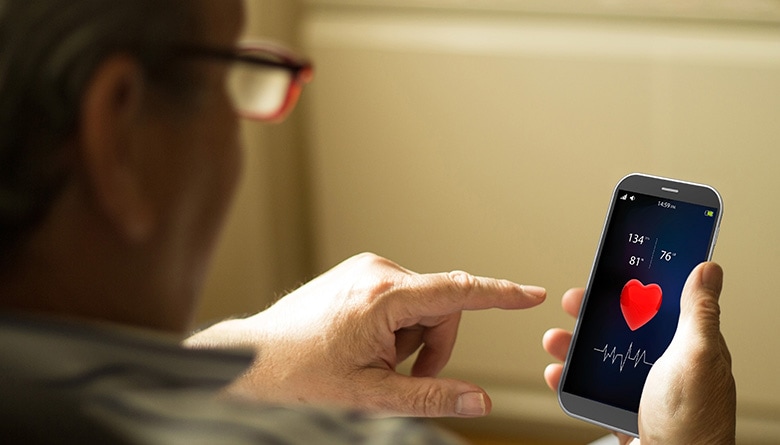 |
The author of this article is Warren Harding, Deputy Chair, Alzheimer’s WA. |
At a time when staying connected and engaged with loved ones has never been more important digital health, assistive devices, independent living aids and adaptive equipment can help with independent living and also support carers.
The role of technology in healthcare is to improve quality of life, improve services and access for patients and increase provider capabilities. Artificial intelligence, machine learning and the internet are already supporting robotic surgery, clinical decisions and helping predict future treatment. Predictive healthcare and personalised medicine are changing the way healthcare is delivered to improve quality of life. For people living with dementia, there are some exciting developments.
Assistive technology is equipment, software or digital devices that are used to increase and maintain health, overcome cognitive impairment, difficulties and disabilities. Lower costs and better integration of devices are assisting independent living, reducing healthcare costs, and improving health outcomes. In a recent global industry report, the disabled and elderly assistive technology market was valued at approximately USD $18.7 billion in 2017 and is expected to grow to USD $30.8 billion by 2024, growing at around 7.4 per cent.
Digital health is transforming independence
Falls, getting lost and disorientated are common concerns for people living with dementia and their families and assistive technology can make their daily living activities such as dressing, bathing, grooming and meal preparation easier, and live longer with greater independence.
We are seeing some very exciting clinical breakthroughs in robotics and chronic disease management. Artificial intelligence is changing the way health care is practiced in the fields of image based medical specialities such as radiology, dermatology and ophthalmology. Using deep learning techniques, medical images are being read and graded to support clinical decision making for doctors. Artificial intelligence can also support day-to-day living and decision making for those living independently with alerts for medication and reminders to their loved ones.
Digital health is also assisting automated eye scanning for early detection of Alzheimer’s disease. This is evident in the work of Professor Ralph Martins, AO on early amyloid detection and use of biomarkers in the eye, brain, skin, lumbar fluid and blood to detect and then enable preventive measures such as those being examined in the World Wide Fingers trial around brain health and overall health functioning. With over 459,000 Australian’s living with dementia, a figure that is expected to grow to over a million by 2058, Alzheimer’s poses a $818 billion global economic challenge.
Examples of assistive technology include screen reading assistance; audio, video and hologram communication with families through tablets and smartphones; robotics for operation of appliances, memory and reading assistance; telemedicine, smart medication management; telemetry and home sensor technology predicting and identifying the occurrence of falls in the home; and brain training games for therapy and relaxation.
The cost and future of aged care
With nearly 4 million people in Australia aged 65 or older, and projected growth to 8.7 million by 2026 there is an urgency to overhaul Australia’s aged care system. In 2018 more than 282,000 older people made up the population in residential aged care and more than 783,000 people received home support through the Commonwealth Home Support Program (CHSP). It costs the Federal Government over $18 billion which will rise to $24 billion by 2022. Moreover, in 2015, over one in eight Australians (2.86 million), were estimated to provide informal care. About 1.9 billion hours of care were provided in 2015 with a replacement value of $60.3 billion.
The number of people receiving Home Care Packages which are designed to provide more support for the complex aged care needs beyond what the CHSP offers has increased by 10.6 per cent since June 2019 and there has been a 30.2 per cent annual increase from September 2018. In short, Australians are ageing and the capacity of the current system to be funded adequately will demand a major overhaul of State and Federal responsibilities and future funding levels.
Alarmingly, the Royal Commission into Aged Care Quality and Safety found that during the year ending June 2018 more than 16,000 people died waiting for a package. It also told of far too many stories of poor incontinence management, medication management, wound treatment and elder abuse. The time for change is upon us and while various States are progressing legislation for voluntary assisted dying to help those eligible people to “die with dignity’, as a nation we need to do much better to help people “age with dignity”.
The trends in data show that many older Australians are reluctant to enter residential aged care preferring to remain living at home as they age. Ageing-in-place is not only about living at home, but also about “active ageing” where older people remain connected to their neighbourhood and community. Ageing with dignity is also linked to improved quality of life, maintaining control and independence.
The research report on Assistive Technology for Older Australians (2018) included an evidence-based review of the cost benefits of using assistive technology to deliver independence, autonomy, safety and participation for consumers. It also called out that provision of assistive technology in Australia is currently inequitable, inefficient and fails to maximise Government expenditure. A paper by CQUniversity in 2018 quantified the return on investment on the use of smart home technology by decreasing the financial burden of residential care costs, a reduction in aged care service hours, fewer hospital fall admissions and re-admissions (in Western Australia, between 2000-2008 over 585,000 bed days at a cost of $617 million were for falls), and an increase in quality adjusted life years.
I expect the findings of the Royal Commissions into Aged Care Quality and Safety and into NDIS will lead to novel models of health care that delivers person-centred, timely, safe and effective care for older Australians and those with disabilities resulting in improved outcomes, better efficiency of care, and greater value for the expenditure.
But what does the future of assistive technology look like?
By utilising a series of unobtrusive smart sensors in the home to monitor sleep, temperature, movement, use of microwave, refrigerator, washing machine, door open/close sensors, bathroom visits and resting, real-time information can be gathered on a person’s activity, routine and health indicators. This profile then helps families and care professionals define, monitor and assess care plans and strategies enhancing their quality of life and confidence.
Artificial intelligence learns the profile of the person and then alerts carers if there is any profile deviation from normal activities or if a door has been left open. As an example, the person may visit the bathroom at 9pm, go to bed at 10pm, spend an hour watching television and turn the lights off at 11pm, and routinely get up once during the night. Carers will be alerted if this pattern changes such as the person getting up more often in the night to use the bathroom, which could be indicative of an early onset urinary tract infection.
The family and carers can also plan an active role by accessing the mobile app on their smartphone or tablet providing both parties with a view into the person’s wellbeing and any action needed to address incidents or issues with their daily routine.
Devices such as wearables, GPS pendants for location tracking and emergency alerting outside of the residence, smart smoke detectors and RCD devices, and remote biometric devices such as blood pressure cuffs, smart scales and vital statistic monitoring devices can also be integrated.
In Western Australia, given the remoteness of the State, the need for people to age in country, and as a response to COVID-19, there is a project planned by the Indo Asia Centre for Digital Health to improve GP’s use of telehealth and pharmacies to better monitor patients at home. This can reduce pressure on the healthcare system by using mobile devices and wearables to track vital signs including respiratory rate, heart rate, blood oxygen levels and temperature. It could also deliver pharmacy medications remotely and use geofencing to ensure people are in their home or during a pandemic, are self-quarantining and can be tracked and traced.
The Australian Federal government is supporting the use of tele-consultations for seniors and to reduce potential for COVID-19 transmission extended the program. Clearly, this could be the new norm for aged care and those wishing to live longer and more independently in their home.
What kind of assistive technology is right for your loved one?
Key benefits to elders, their family and loved ones, and healthcare providers are to:
- Improve wellbeing and quality of life
- Facilitate a desire to live at home longer and utilise technology to relieve the growing burden and cost of aged care
- Provide family and carers a real-time view of activity in the residence using smart sensors which drive analytics to understand people’s routines and monitor their wellbeing
- Higher quality of care and improved efficiency.
Assistive technology comprises a wide range of products and devices and there are a few tips to help:
- Focus on the actual task where assistance is needed
- Find solutions that can be integrated into your normal routine without causing confusion, anxiety, or with minimal disruption
- Involve the person living with dementia in decisions about which product or solution to use, ensure they understand the ethical issues of using assistive technology and ensure their consent
- Introduce assistive technology when the dementia is still at an early stage, so the person can gradually get used to new ideas.
Most often, the choice of assistive technology is a decision you make with your loved one, other family members and you can seek assistance from a specialist from Alzheimer’s WA.

 Listen to this page
Listen to this page

